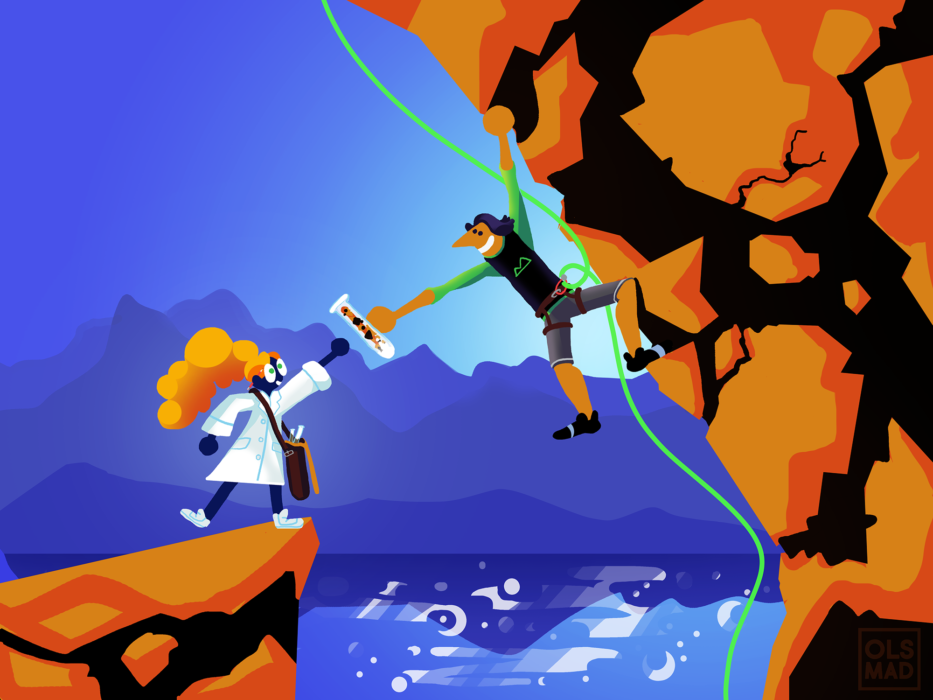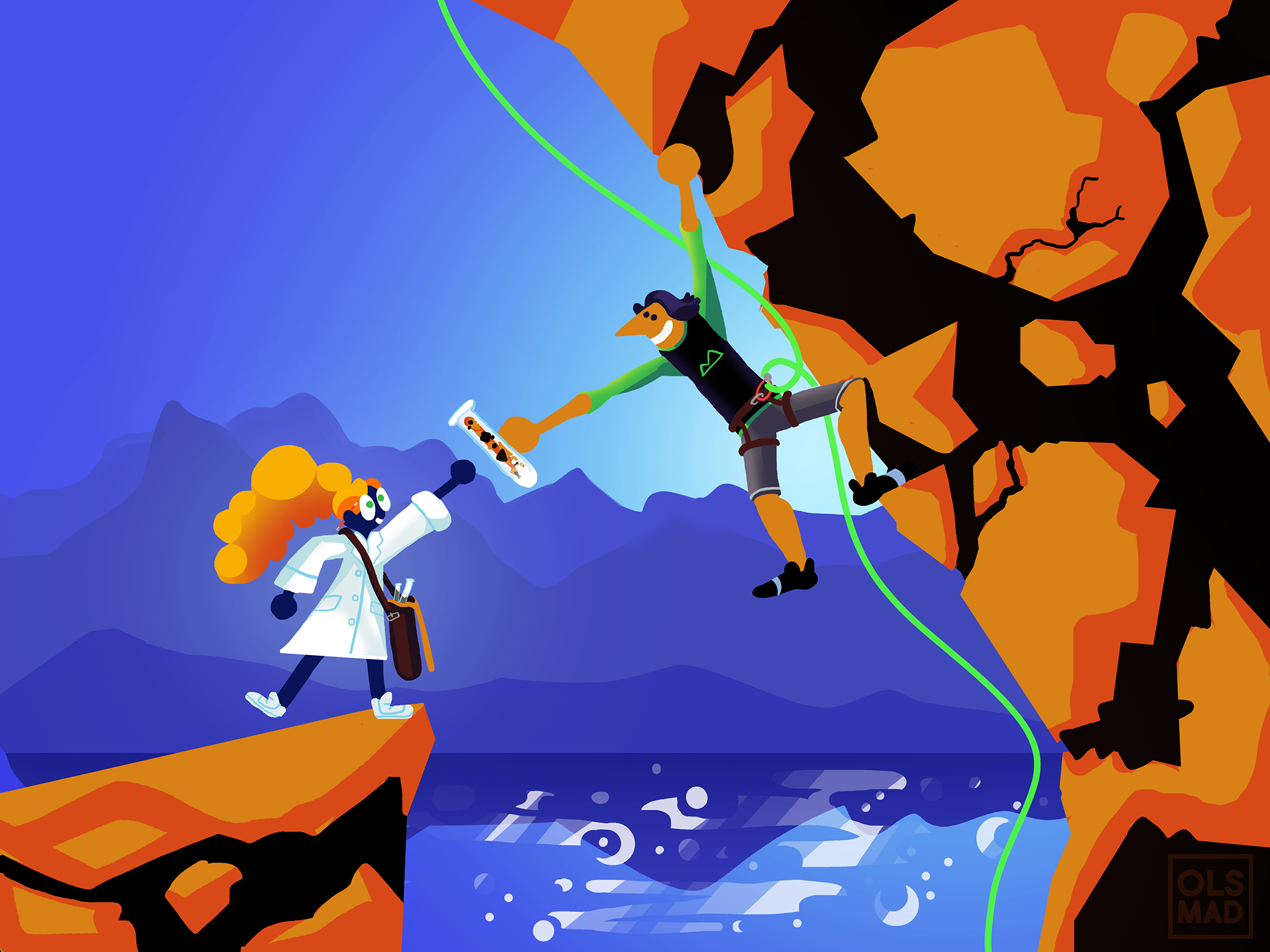
Monte Alves has a bit of a competitive streak. He was a die-hard whitewater kayaker until he had kids and was spooked into (slightly) tamer pursuits. Nowadays, he skis and mountain bikes, but the edge remains. “I always love going out and doing something beyond what everybody else is doing,” he said.
I met up with Alves at a popular trailhead in Washington’s Cascades this June, and spent the subsequent hours struggling to keep pace with the supremely fit 47-year-old on his bike. Fortunately for me, there were a couple stops baked into our 5.7-mile, 3,400-foot climb up the flanks of Mount Washington. After all, we were there in the name of science, and there was work to be done.
Twice, we dismounted from our bikes to collect samples from Western red cedar, one of the towering trees of ubiquity in the Northwest. At each tree, Alves snapped a photo and recorded its GPS coordinates. He then grabbed samples of the tree’s leaves and cones, and placed them in bar-coded sample envelopes. He took a sample from one tree’s trunk using an increment borer. Alves hand-drilled the tool’s sheath into the tree, then inserted a tube into its hollow center. With a twist, he pulled out a narrow cylinder of the tree’s guts. We counted the rings; this cedar, a little over 4 feet in circumference, was about 70 years old.
Red cedar’s fragrant wood is prized for its rot-resistant properties, making it ideal lumber for decks, fences, and shake siding and roofing. And if it’s prized by loggers, it’s prized by illegal loggers. Hard numbers are difficult to come by, but the international trade of illegal lumber is estimated to be at least $50 billion. A chunk of that is red cedar, and Alves was doing his part to slow cedar poaching.
Alves is a volunteer with Adventure Scientists, a Bozeman, Montana-based firm that connects hikers, kayakers, and other outdoor enthusiasts with scientists in need of hard-to-get data. Since its 2011 inception, volunteers have assisted with more than 130 projects. Last year, 314 adventurers collected samples for the scientists.
“It’s neat for me to go mountain biking … and then have bragging rights,” Alves said. “I’m also doing data collection for a greater purpose.”
Bitterroot hinges on the support of its readers.
Contribute to our reporting today.
The U.S. Forest Service will use the samples Alves collected to generate chemical signatures and genetic libraries of cedar trees around the West Coast. If robust enough, these reference libraries can be used to identify where a given log was cut, thus allowing regulators to flag illegally harvested trees. Over the last two years, Adventure Scientists volunteers obtained 5,336 samples of red cedar, yellow cedar, redwood, and bigleaf maple.
Adventure Scientists’ volunteers have contributed to numerous studies over the past nine years. Its brand of citizen science also represents a burgeoning shift in the ethos of outdoor recreation. So many of us hit the trail and focus blithely on ascending mountain peaks or running faster than before, never stopping to closely pay attention to the flora and fauna that surround us. But, by contributing to research, some outdoor enthusiasts are slowing down, paying more attention to the public lands they recreate on, and giving back to that land.
Gregg Treinish, the 37-year-old founder of Adventure Scientists, spent much of the 2000s walking. In 2004, he completed the 2,190-mile Appalachian Trail. Four years later, he finished a 7,800-mile trek along the entire Andes range in South America.
After the Andes, Treinish figured there were plenty of folks like him who loved recreating outdoors, and would happily help scientists better understand the places where they climbed, hiked, or skied. He started Adventure Scientists in January 2011. “And by May, we had successfully collected the highest known plant life on Earth, on Mount Everest, and we had started sending people all around the world,” Treinish said.
Adventure Scientists volunteers spent four years collecting water samples to help scientists document the prevalence of microplastics in the global water system. Hikers and trail runners have monitored martens on Washington’s Olympic Peninsula, lynx in Montana, and wolverines in the Uinta Mountains of Utah. They’re currently cycling Montana highways on the lookout for roadkill, which will tell the state department of transportation where to build wildlife over- and underpasses. Over the next four years, volunteers will test water quality in the nation’s federally protected Wild and Scenic rivers.
Early on, Treinish was simply connecting individual adventurers and researchers. Since then, Adventure Scientists has morphed into a full-fledged research consultancy. Before any volunteer solicitation takes place, Treinish works alongside scientists to determine what data they need, where they can get it, and what permits might be required. The organization also serves as a go-between for various parties that might be interested in the data. Ahead of the Wild and Scenic Rivers survey, for instance, Treinish’s team coordinated 40 state and five federal agencies collaborating on the project.
Projects must meet three criteria before Adventure Scientists will put its network of adrenaline junkies to the task. First, researchers must be looking into a conservation or human health issue that needs more data to enable a solution. Next, the data must be robust enough to, potentially, yield years of insights. Finally, there must be a need for outdoor enthusiasts to collect said data.
The capabilities of Adventure Scientists’ network mean data can be collected from spots the typical volunteer, or scientist for that matter, usually can’t reach. Over the course of the four-year microplastics study, volunteers collected 2,677 water samples across the globe, and they weren’t coming just from popular beaches. “The average Joe isn’t kayaking in the Northwest Passage, or sailing across remote islands in the South Pacific,” said Abigail Barrows, a biologist at the College of the Atlantic and principal investigator of the Global Microplastics Initiative. Barrows’ research found that microplastics are far more common in our oceans than models previously indicated.
Katy Prudic, a wildlife biologist at the University of Arizona, said Adventure Scientists’ volunteers helped improve models of butterfly ranges around North America. “People tend to collect data within two hours of their homes,” she said. “So that leaves a lot of space, particularly in the West, where you have to make estimates with very little data.”
In summer 2017, volunteers hiked a cumulative 810 miles to log butterfly and wildflower data. Their observations will help Prudic and other researchers understand how climate change and human development affect pollinators, thus informing future conservation efforts.
As for the microplastics data, Barrows said the requests for access from governments, college students, nongovernmental organizations, and even individuals keep pouring in. “They’re doing their own analysis, or using it to drive legislation,” she said.
Adventure Scientists isn’t the only organization putting athletes to work for science. At the University of Utah, geologist Jeff Moore enlisted climbers to help him measure the seismic vibrations that pulse through the state’s landmark arches and towers, which offer insights into their structural integrity. Most of the arches were relatively easy to access, but some required technical expertise.
“It’s easy to explain to [advanced climbers] the process of taking measurements, and to have confidence that they’ll execute that reliably,” Moore said. “They have, already, this technical mindset for details. … It’s not terribly tricky, but you have to do it right.”
Ben White signed up to help Moore a few years back, when he was an undergraduate at the university. White is a backcountry skier and paraglider, but helping Moore set up seismometers and learning of the gentle pulse that rolls through them had him thinking about these landscapes in a new light.
“The arches are really special, and in a geological sense, they barely even exist,” he said. “Arches exist [for] thousands of years. On a scale of millions of years, it’s nothing. … These amazing — in human time — ‘forever’ structures are actually ephemeral in the grand scheme of things.”
For some, there’s an ethical component to the work. Kat Vollinger was another of Moore’s volunteers. Vollinger, who now works at Mount Rainier National Park, is a highly skilled climber, so Moore enlisted her two years ago to ascend Castleton Tower, a 400-foot sandstone tower near Moab, and a few other arches. To Vollinger, the citizen science was a mechanism for “making climbing less selfish.” She said she appreciates the mental and physical challenge of climbing, and appreciates the connection with nature it facilitates. But with that comes a cost.
“There’s an environmental expenditure — flying or driving to places. It’s definitely not a small impact,” she said. “So I think it’s appropriate to help the research that’s going on out there.”
Some who use public lands already give back. Hunters are a case study — they directly subsidize wildlife management through their licenses and taxes on firearms and ammo. But most of us visit a trail, enjoy it at the cost of a minuscule slice of our tax bill or recreation pass, and then go home without much thought. And in some instances, outdoor recreation can be downright detrimental. Heavy trail use, for instance, can impact wildlife and degrade native vegetation.
“That culture of outdoor enthusiasts can be frustrating sometimes … when it’s about the equipment, or the personal pursuit on the landscape,” Michelle Toshack, Adventure Scientists’ volunteer experience manager, said. “There’s also a responsibility that comes with it. You’re not going to be able to bag that peak or crush that mountain bike trail if that area is not protected, or if thousands of other people are destroying the trail.”
A big allure of Adventure Scientists is its ability to get a lot of data, fast. But an inverse reaction also takes place: the speed freaks collecting data tend to slow down. Take Alves, for instance. His volunteering forced him to keep an eye out for cedar’s tell-tale swooping branches and striated bark; now, he can’t not see them. As we descended on our ride, he’d shout “Cedar!” whenever we passed a big one. He also grasped the reality of timber poaching. During a sampling trip at a state park along the Puget Sound, a ranger told him that a huge red cedar had been cut down nearby. Red cedar is common, but old-growth ones aren’t, and a big tree can fetch tens of thousands of dollars.
Learning that added heft to Alves’ volunteer work. Now, “while everybody at camp is drinking beer, I’m out taking tree samples.”
What Treinish envisions for Adventure Scientists’ future is a sort of flywheel effect, in which science and those who spend a good deal of their free time outdoors more often blend — thus boosting the quality of science and solidifying a connection between recreation and conservation.
“We as the outdoor community are the people who love these places. If we’re not the voice for these places, if we’re not the labor for these places, nobody else is gonna be,” Treinish said. “That yields a pretty intense and profound opportunity that we have.”

